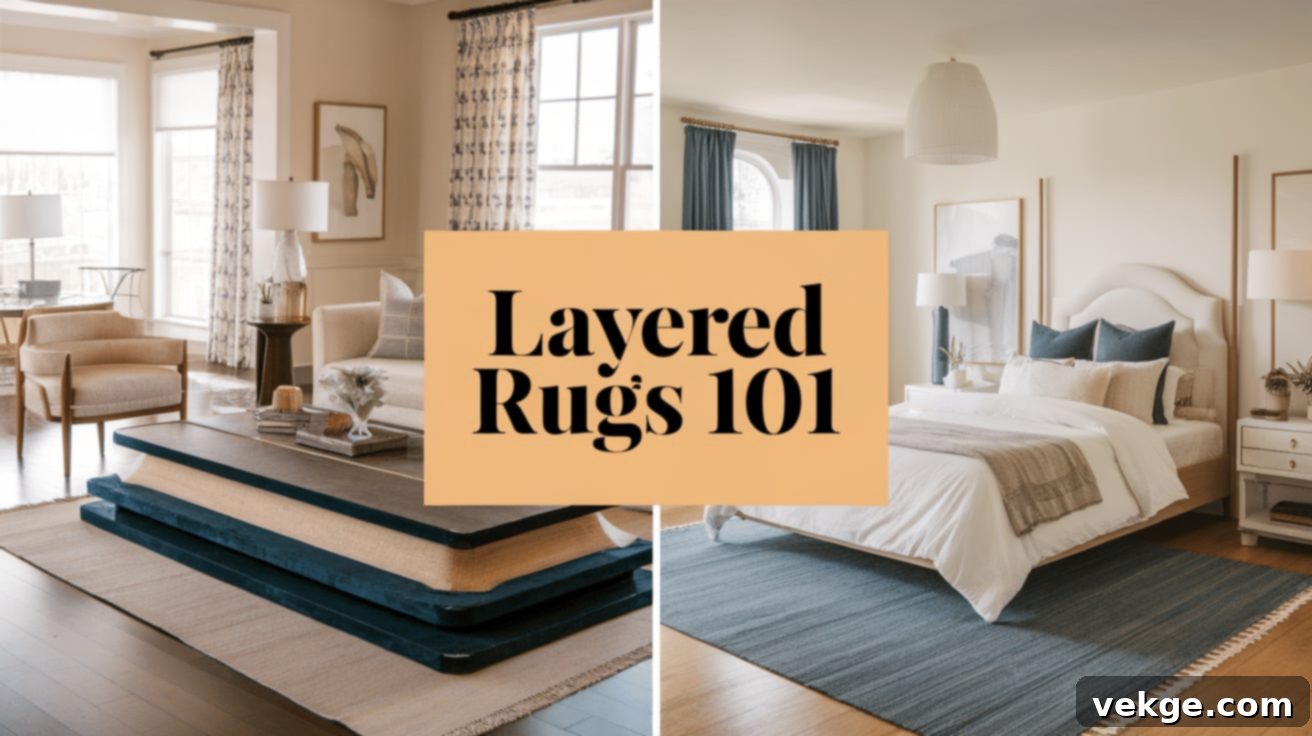The Ultimate Guide to Layering Rugs: Transform Your Space with Style and Warmth
Layering rugs is a design technique that can profoundly elevate the warmth, depth, and style of any room. Far from merely covering a floor, it’s an art form that makes a space feel more inviting, cozy, and uniquely personal. By thoughtfully combining different colors, patterns, and textures, you can completely redefine the ambiance of a room without undertaking a major renovation.
However, getting it right requires a keen eye for balance. The wrong size can throw a room off-kilter, while too many layers might look cluttered rather than chic. Over the years, I’ve discovered that a few fundamental principles make all the difference. Choosing the correct rug sizes, complementary textures, and strategic placements can transform a potentially messy look into a beautifully curated space. The good news? You don’t need a huge budget or a professional designer’s intuition to master this skill.
With the right approach, layering rugs can be an incredibly fun and straightforward way to inject personality into your home. This comprehensive guide will share the best strategies for layering rugs, ensuring your space looks perfectly put-together, sophisticated, and utterly welcoming, rather than disheveled or chaotic.
Why Layer Rugs? Unveiling the Benefits of This Design Trend
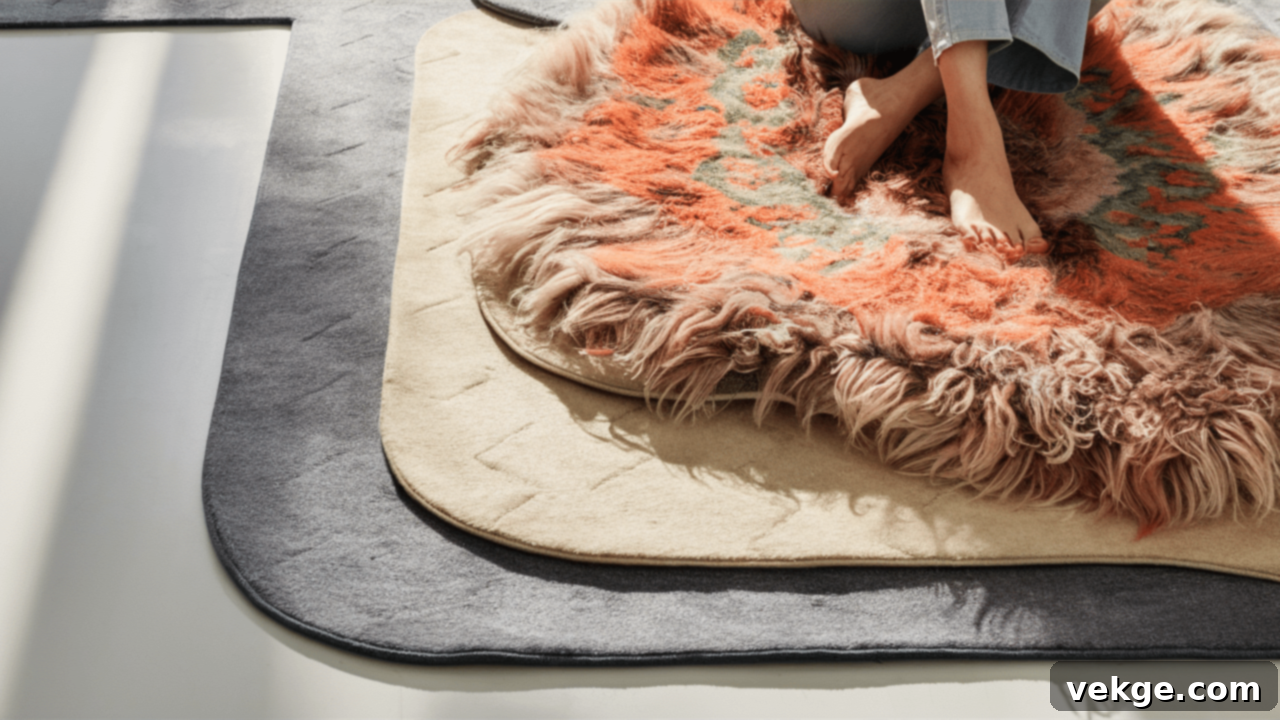
Layering rugs is more than just a fleeting decor trend; it offers a multitude of practical and aesthetic benefits that significantly enhance the comfort, style, and functionality of any living area. If you’re wondering whether to embrace this technique, here’s a closer look at why it’s a worthwhile endeavor for your home.
Adds Unparalleled Warmth and Comfort Underfoot
While a single rug undeniably adds a degree of warmth to a room, layering takes this comfort to an entirely new dimension. Imagine the luxurious feeling of a thick, plush rug laid over a soft, flatweave foundation. This creates an extra layer of cushioning that is incredibly pleasing underfoot, making it an ideal choice for high-comfort zones like living rooms, bedrooms, and nurseries where relaxation is paramount.
Beyond the tactile pleasure, layered rugs are incredibly practical, especially during colder months. They act as an additional insulator, trapping warmth and adding softness to otherwise hard floors. Furthermore, the combined thickness of multiple rugs significantly helps in absorbing sound, which can transform a noisy, echoey space into a quieter, more serene, and inherently cozier environment. For households with children or pets, layered rugs also offer a practical safety benefit by providing a softer landing surface, reducing the impact of accidental falls.
Introduces Rich Texture and Visual Depth
Layering rugs is an exceptionally effective method for introducing rich texture and profound visual interest to a space. By intentionally combining materials with varying tactile qualities, you can create a captivating contrast that makes a room feel instantly more inviting and dynamic. This interplay of textures prevents a room from feeling flat or one-dimensional.
For instance, consider layering a robust, smooth jute or sisal rug beneath a luxuriously soft wool or cotton rug. This pairing adds immense dimension without overwhelming the visual space. Alternatively, placing a deep-pile shag rug on top of a sleek flatweave rug can evoke a wonderfully cozy and opulent feel. The secret to success lies in mixing distinctly different materials, ensuring that each layer contributes its unique character rather than blending indistinctly into the other.
Facilitates Effortless and Economical Style Transformations
Are you constantly seeking ways to refresh your home’s aesthetic without committing to expensive overhauls? Layering rugs offers an ingenious solution. Instead of replacing a large, costly main rug every time your style preferences shift, simply swapping out the smaller top rug can instantly revitalize the entire space. This strategy is particularly brilliant if your base rug is a versatile, neutral piece.
By rotating your top rug seasonally or whenever you crave a fresh look, you can keep your interiors feeling current and inspiring without straining your budget. For example, a vibrant, boldly patterned rug can serve as a cheerful accent during the spring and summer, which can then be easily exchanged for a deep-toned, soft, and warm rug in the autumn and winter months to cultivate a cozy, cocoon-like atmosphere.
Clearly Defines Spaces in Open-Concept Layouts
In the popular open-concept homes of today, the absence of traditional walls can make it challenging to delineate distinct functional zones. Layered rugs provide an elegant and effective solution to this design dilemma, helping to visually carve out separate “rooms” within a larger, unified area. This technique creates psychological boundaries without physical barriers.
For example, a substantial, neutral base rug can effectively anchor and define a living area, with a smaller, more decorative rug layered on top to highlight a seating arrangement or coffee table. Similarly, another rug placed beneath the dining table can clearly mark the dining zone. This strategic use of layered rugs works exceptionally well in lofts, studios, and any open-plan residence where clear, yet fluid, boundaries are desired to enhance both aesthetics and functionality.
Offers Enhanced Protection for Floors and Valuable Rugs
High-traffic zones within a home, such as entryways, hallways, and central living areas, are naturally subjected to significant wear and tear. Layering a smaller, more durable rug on top of a larger, potentially more delicate one serves as an excellent protective measure. This technique effectively shields the base rug from the brunt of daily dirt, accidental spills, and the constant friction of foot traffic.
This protection is particularly invaluable for expensive, antique, or vintage rugs that you wish to preserve. Rather than exposing these treasured pieces to everyday wear, a more robust and easy-to-clean rug can be strategically placed on top. This not only extends the lifespan of your valuable base rug but also allows you to enjoy its beauty as part of a stylish, well-protected arrangement.
Step-by-Step Guide to Perfectly Layering Rugs for a Cohesive Look
Achieving a harmonious layered rug aesthetic isn’t about haphazardly throwing rugs together. It requires a thoughtful selection process where not all rugs are compatible. To create a truly balanced and inviting look, you’ll need to meticulously pick the right sizes, textures, and colors that complement each other. Follow these steps to master the art of rug layering.
1. Start with a Large, Anchoring Base Rug

The base rug is the foundational element of your layered design; it sets the stage and grounds the entire space. It is crucial for this rug to be generously sized, covering a significant portion of the floor and effectively anchoring the furniture arrangement within the room. Think of it as the canvas upon which your artistic layering will unfold.
Popular and highly effective choices for base rugs typically include materials known for their durability, neutral aesthetics, and relatively low profiles:
- Jute or sisal rugs: These natural fiber rugs offer a beautiful neutral canvas with inherent texture. They are incredibly durable, eco-friendly, and provide a perfect, earthy foundation for almost any layering style.
- Flatweave rugs: Lightweight, often reversible, and exceptionally easy to clean, flatweave rugs are ideal base layers. Their slim profile ensures that the overall layered effect doesn’t become too bulky or create tripping hazards.
- Low-pile rugs: Whether made of wool, cotton, or synthetic fibers, low-pile rugs are excellent as base layers because they don’t add excessive height. This keeps the multiple layers even, stable, and visually balanced.
Tips for Selecting Your Base Rug:
- Ensure the base rug is substantial enough, ideally extending at least 12–24 inches beyond the edges of your top rug on all sides. This creates a clear border and emphasizes the layered effect.
- Opt for neutral colors (creams, grays, tans, natural tones) for your base rug if you intend for the top rug to be the primary focal point and introduce vibrant color or pattern.
- Given its role in anchoring the room, select a durable material that can withstand general wear and tear, especially if layering in a high-traffic area like a living room or entryway.
2. Introduce a Smaller, Captivating Top Rug
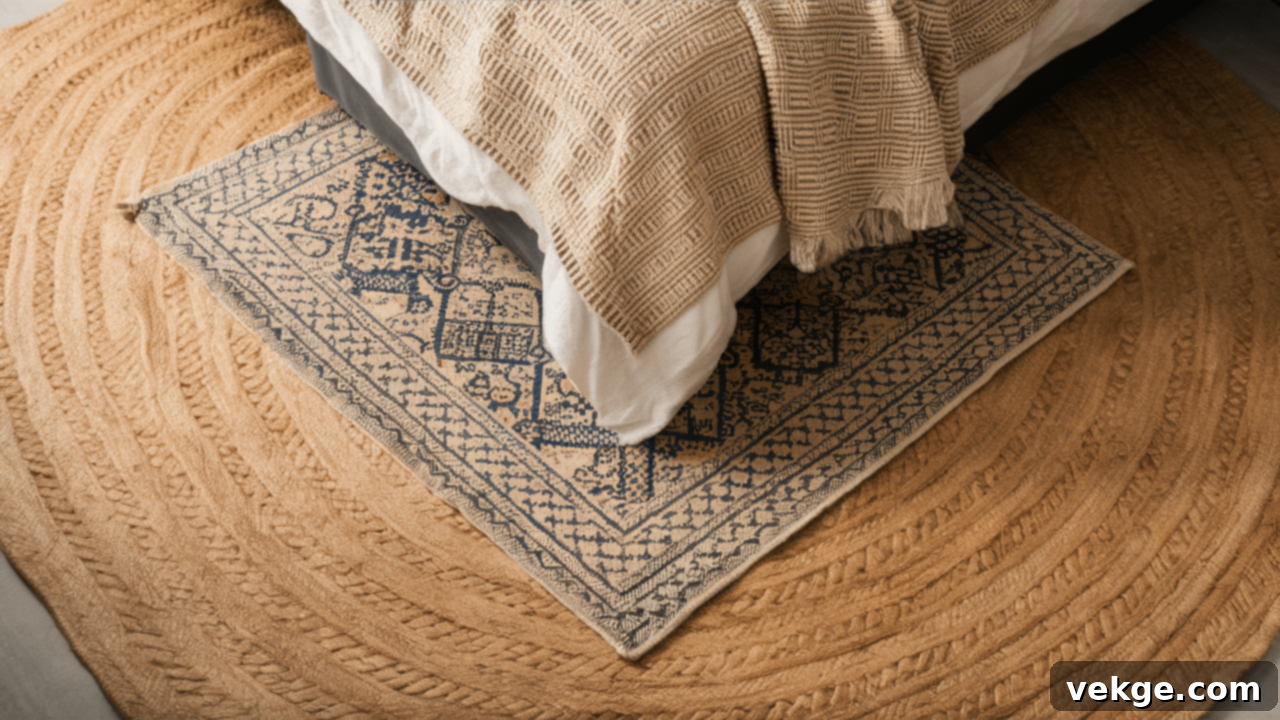
The top rug is your opportunity to unleash creativity and introduce personality into your design. This rug should be noticeably smaller than the base rug, creating a clear visual distinction, yet still substantial enough to make a significant decorative impact and define a specific zone within the room.
Excellent choices for top rugs are those that offer a contrasting element, whether through pattern, color, or a more luxurious texture:
- Patterned rugs: If your base rug is solid and neutral, a patterned top rug is a fantastic way to infuse color, intricate design, and a focal point into the space.
- Shag rugs: For an immediate boost of softness and a wonderfully cozy, tactile experience, a shag rug as the top layer is unparalleled. It adds a sense of warmth and luxury.
- Vintage rugs: A well-chosen vintage rug brings a timeless, unique, and often story-filled touch to your home. Its aged beauty and rich history can become a striking centerpiece.
Tips for Selecting Your Top Rug:
- If your base rug is solid or neutral, don’t shy away from choosing a top rug with a bold pattern or vibrant colors to add visual interest.
- Conversely, if your base rug already features a prominent pattern or texture, opt for a solid-colored or subtly printed top rug to maintain balance and prevent visual chaos.
- Ensure the top rug is not too small; it should define an area (e.g., under a coffee table or at the foot of a bed) and add contrast without being swallowed by the base rug.
3. Master the Art of Mixing Textures for Dynamic Contrast
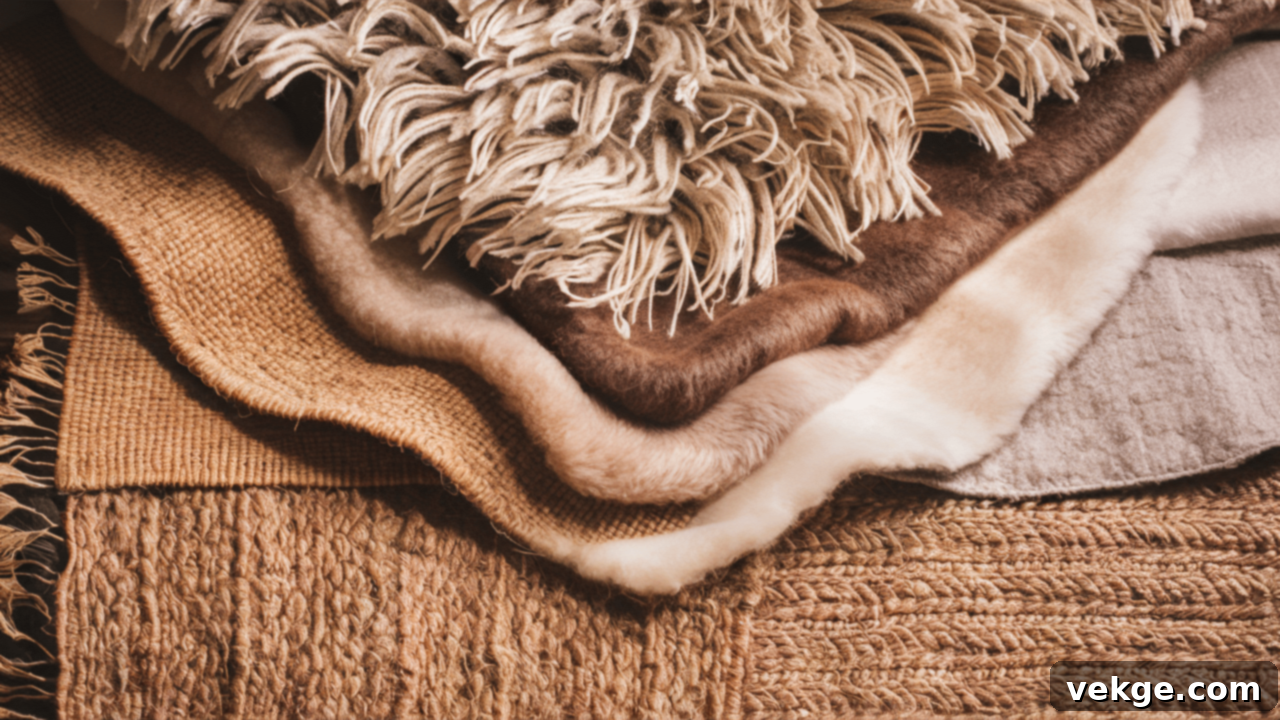
One of the most common pitfalls in layering rugs is selecting textures that are too similar. If both your base and top rugs possess identical or highly similar textures, they risk blending into one another, losing their individual impact and negating the very purpose of layering. The objective is to create a dynamic interplay that captivates the eye.
Here are some tried-and-true ideas for expertly mixing textures to achieve compelling contrast:
- Pair a wonderfully rough and organic jute or sisal rug with the exquisite softness of a luxurious wool or cotton rug. This juxtaposition provides both visual and tactile appeal.
- Layer a sleek, smooth flatweave rug beneath a sumptuously plush shag or sheepskin rug. This combination offers a delightful sensory experience and a striking visual difference.
- Combine a resilient low-pile rug with a dramatic high-pile rug for a visually arresting and dynamic layered look that adds significant depth to your flooring.
Tips for Mixing Rug Textures:
- Avoid layering two thick or high-pile rugs together. This can create an overly bulky, uneven surface that feels uncomfortable, looks clumsy, and may even pose a tripping hazard.
- If you prefer a more understated and subtle aesthetic, experiment with mixing textures within the same color family. This allows the textural difference to be the star, rather than competing colors.
- Always consider comfort underfoot, especially in areas where you’ll be spending a lot of time sitting or walking barefoot, such as living rooms or bedrooms. The layers should feel pleasant.
4. Achieve Balance with Colors and Patterns
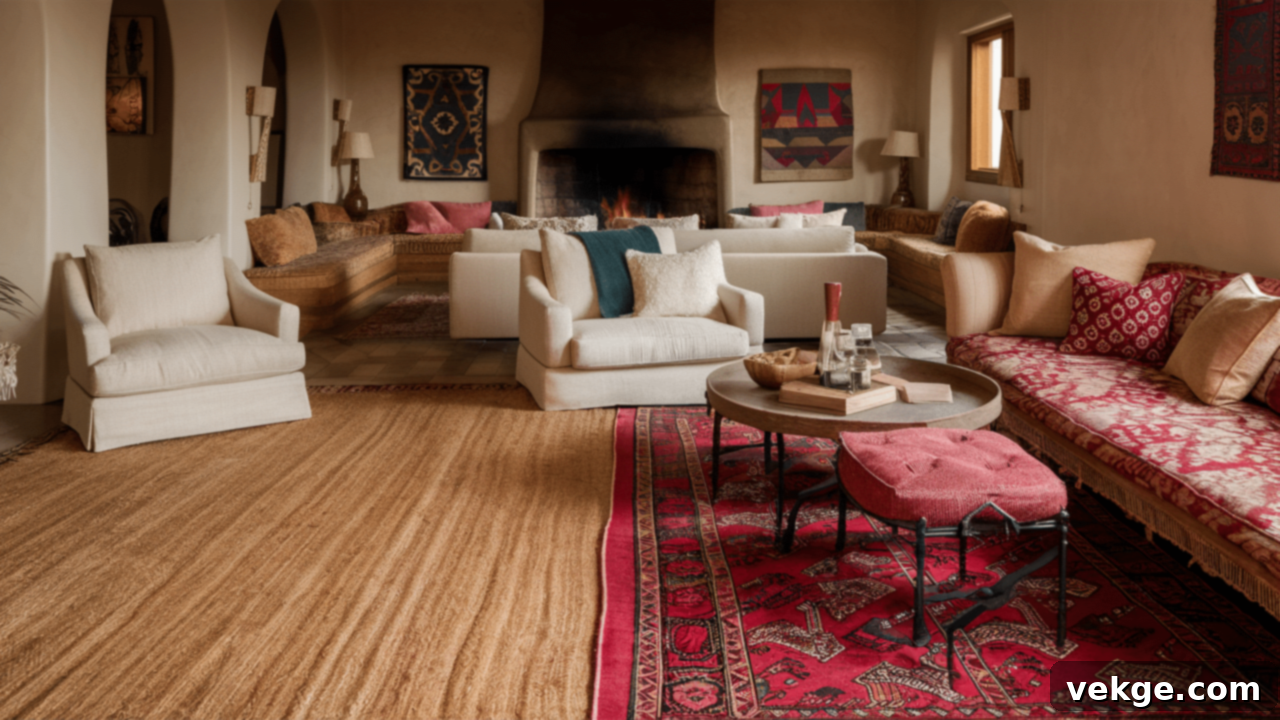
The thoughtful management of color and pattern is paramount in ensuring your layered rugs look stylish and cohesive, rather than chaotic. The goal is to create visual interest and harmony. If your base rug is a neutral hue, you have the freedom to introduce a vibrant, colorful, or intricately patterned top rug. However, if your base rug already features a bold design, the top rug should be simpler and more subdued to avoid visual clashing and maintain equilibrium.
Here are effective strategies for balancing color and pattern in your layered rug arrangement:
- Neutral base + bold top rug: This classic combination allows the top rug to serve as a striking focal point, injecting a pop of color or an engaging pattern without overwhelming the entire space.
- Patterned base + solid top rug: When your foundation rug has a busy design, a solid-colored or subtly textured top rug will effectively ground the look, preventing visual clutter and creating a sophisticated contrast.
- Similar color tones: To achieve a cohesive and sophisticated feel, select rugs that share similar color tones or are from the same color family. This creates a harmonious blend that ties the room together seamlessly.
Tips for Balancing Color and Pattern:
- Always strive for a cohesive color palette. The rugs should either share dominant colors or feature complementary tones to ensure they don’t clash aggressively.
- For a truly pulled-together aesthetic, choose a top rug that incorporates one of the dominant colors found in your base rug, even if in a different shade or intensity.
- If you’re bold enough to layer multiple patterns, vary their scale significantly. Pairing a large-scale geometric pattern with a smaller, more intricate floral or abstract design can work beautifully without competing.
Best Rug Combinations for Striking Layered Looks
Choosing the perfect rug combination is the cornerstone of a successful layered aesthetic. Some rugs inherently complement each other, creating a natural synergy, while others can starkly clash if not thoughtfully paired. The ultimate goal is to generate appealing contrast in texture, color, or pattern, all while preserving a balanced and harmonious overall appearance. Here are some of the most effective and beloved rug combinations and the reasons behind their enduring appeal.
1. Jute + Vintage Rug: A Timeless and Textured Pair
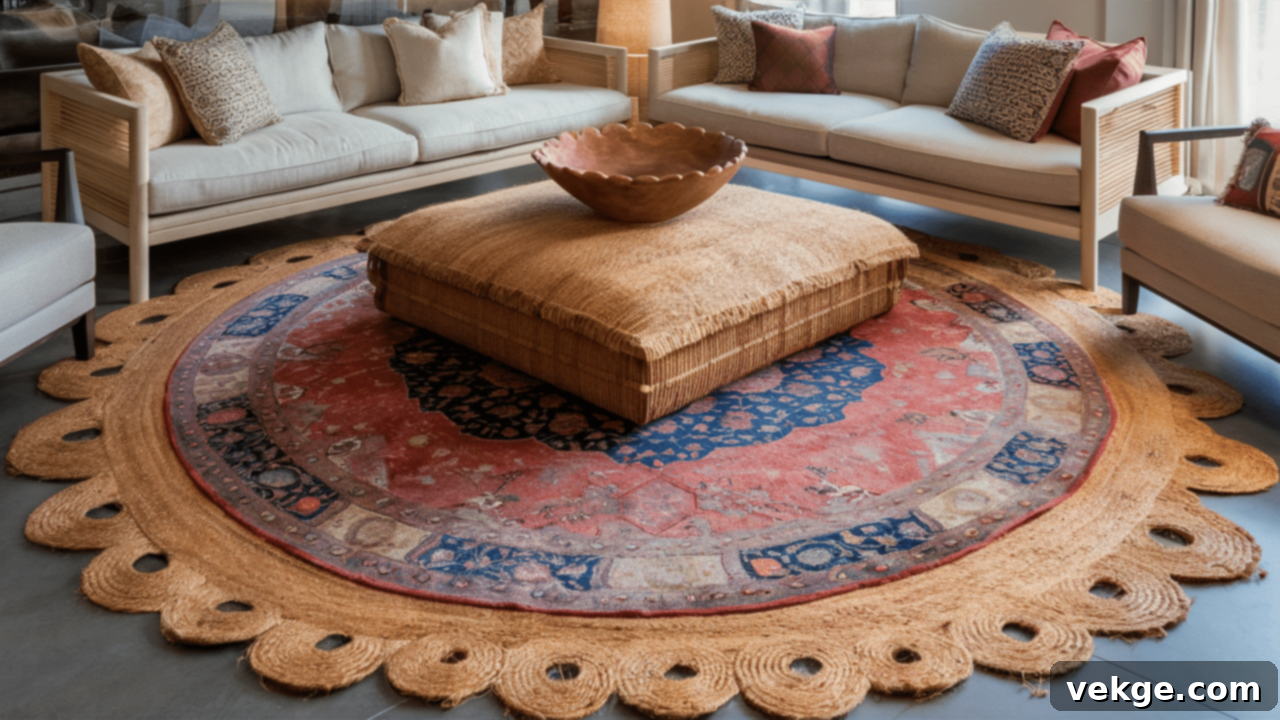
This pairing stands out as one of the most popular, versatile, and enduring rug combinations in interior design, offering a blend of natural earthiness and historical charm.
- Why it works: Jute rugs provide a wonderfully neutral, organic, and highly textured base. Their sturdy yet subtle backdrop allows the often richly colored, faded patterns, and intricate designs of vintage rugs to truly pop and command attention. The natural fibers of jute ground the more elaborate vintage piece.
- Best for: This combination is exceptionally versatile, suiting living rooms, entryways, dining rooms, and bedrooms alike, adding warmth and character to any space.
- Tips: For optimal durability and a neat foundation, choose a jute rug with a tight weave. When selecting your vintage rug, opt for colors that either match, subtly complement, or beautifully contrast with your existing room decor to create a cohesive narrative.
2. Flatweave + Shag Rug: Balancing Structure with Plush Comfort
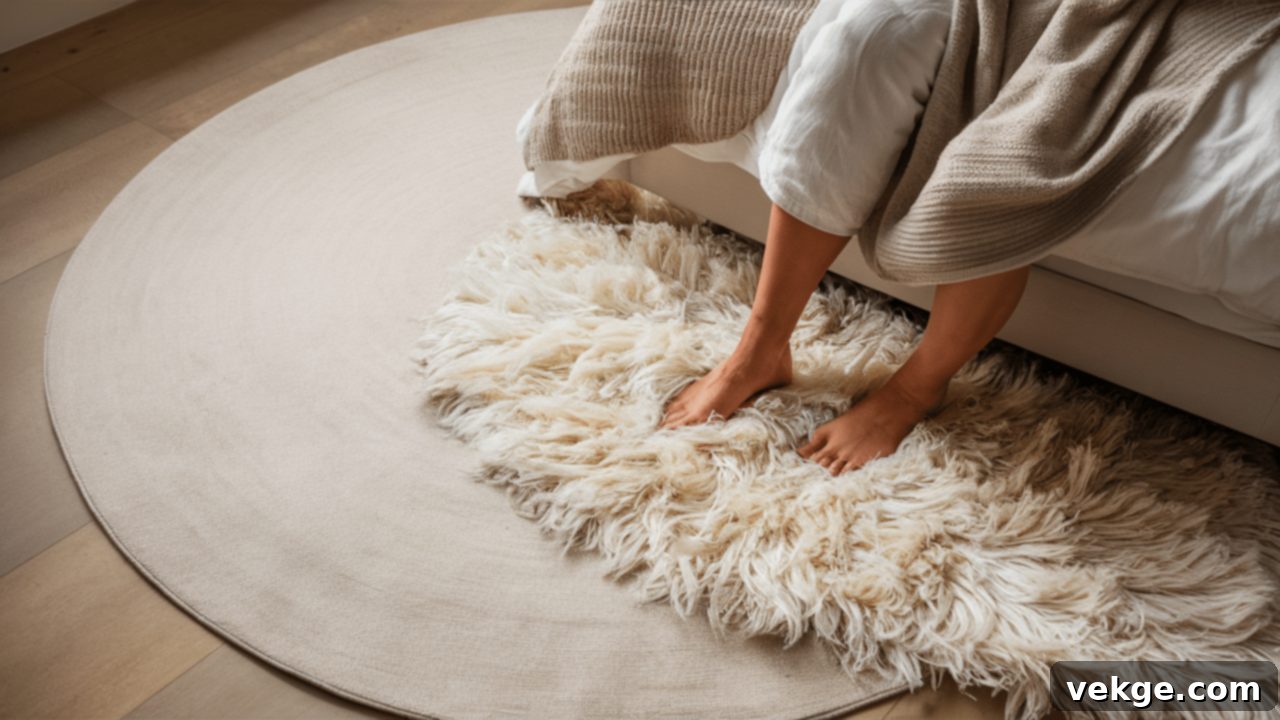
This dynamic combination offers a delightful balance between sleek structure and indulgent softness, creating a rich sensory experience.
- Why it works: Flatweave rugs, known for their thin profile, lightweight nature, and ease of cleaning, make an ideal, stable base. Layering a luxurious, plush shag rug on top introduces an incredible amount of tactile and visual contrast, instantly enhancing the cozy factor of any room.
- Best for: This pairing is perfectly suited for bedrooms, nurseries, and any cozy living area where warmth, comfort, and a touch of luxury are desired.
- Tips: To maximize the visual effect and softness, use a neutral flatweave rug as your foundation. Ensure the shag rug is substantial enough for the space; a too-small shag rug can inadvertently resemble a bath mat rather than a design statement.
3. Neutral Base + Patterned Top Rug: Infusing Character with Ease
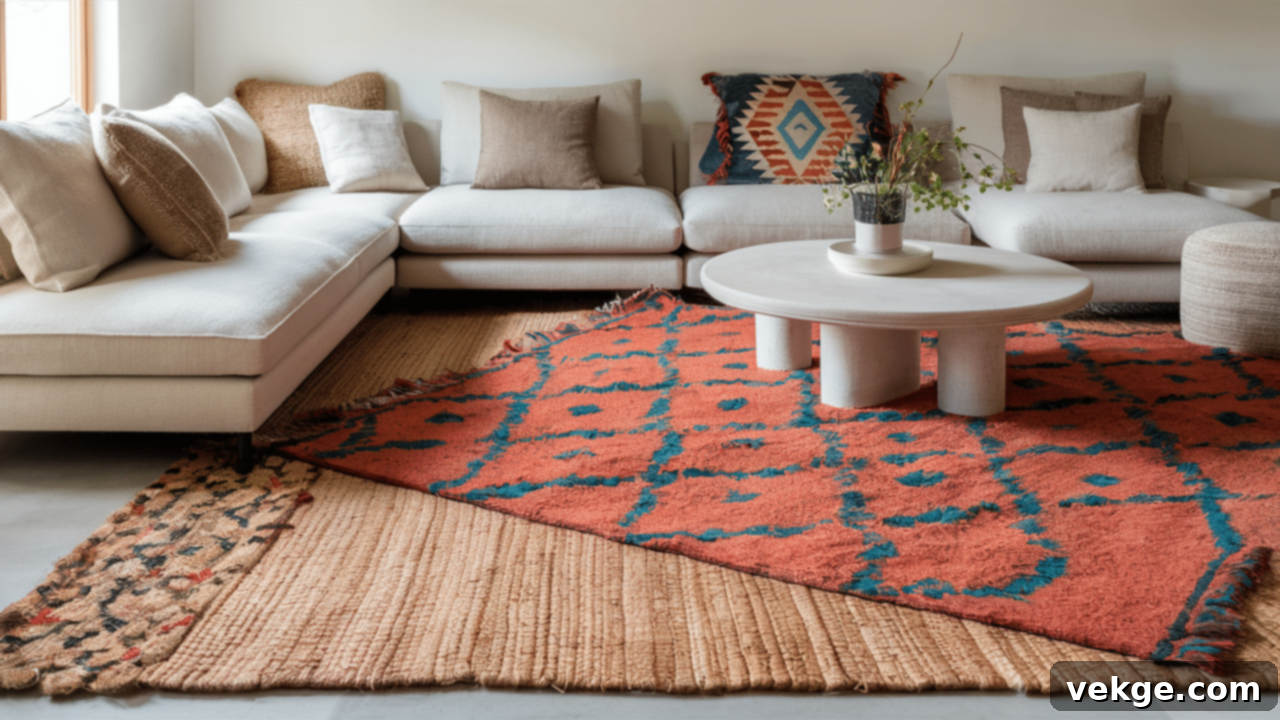
This is arguably the safest yet most stylish method for introducing distinctive character and visual intrigue into any space, allowing for playful expression.
- Why it works: A neutral base rug—be it a classic jute, robust sisal, or a solid wool piece—functions as a pristine blank canvas. This allows a patterned top rug to confidently introduce vibrant color, engaging texture, and a unique personality that truly makes the room sing.
- Best for: This versatile combination is suitable for virtually any room where you wish to add a bold design statement or a pop of color without overwhelming the existing decor.
- Tips: If your chosen top rug features a particularly bold or intricate print, consider keeping the surrounding furniture and decor relatively simple to allow the rug to be the undeniable star. If incorporating multiple colors, ensure they thoughtfully tie into the room’s broader color scheme for a harmonious look.
4. Two Patterned Rugs: The Art of Harmonious Complexity
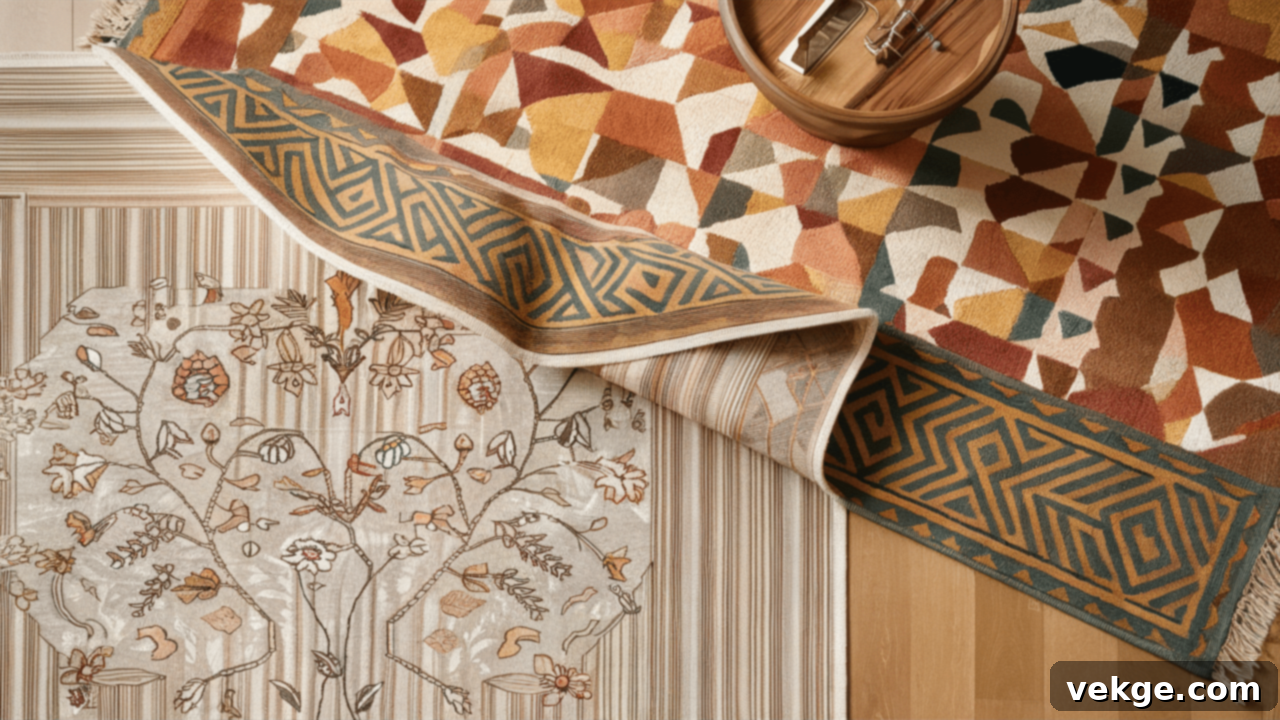
Layering two patterned rugs is a more advanced technique that can result in a strikingly dynamic and exceptionally bold aesthetic when executed correctly, transforming a space into a visual masterpiece.
- Why it works: When carefully chosen, two complementary patterns can create an incredibly rich, layered visual texture that exudes sophistication and creativity. The key is for the patterns to enhance rather than compete with each other, forming a cohesive visual dialogue.
- Best for: This adventurous pairing is often found in eclectic living rooms, bohemian-style spaces, and creative workspaces where a strong artistic statement is desired.
- Tips: The secret lies in using patterns with either similar color schemes (even if the patterns themselves are different) or varying scales. For example, pair a small, intricate geometric print with a large, flowing floral design. To prevent visual overload, keep other elements of furniture and decor simple and streamlined.
5. Cowhide + Flatweave Rug: An Organic and Modern Blend
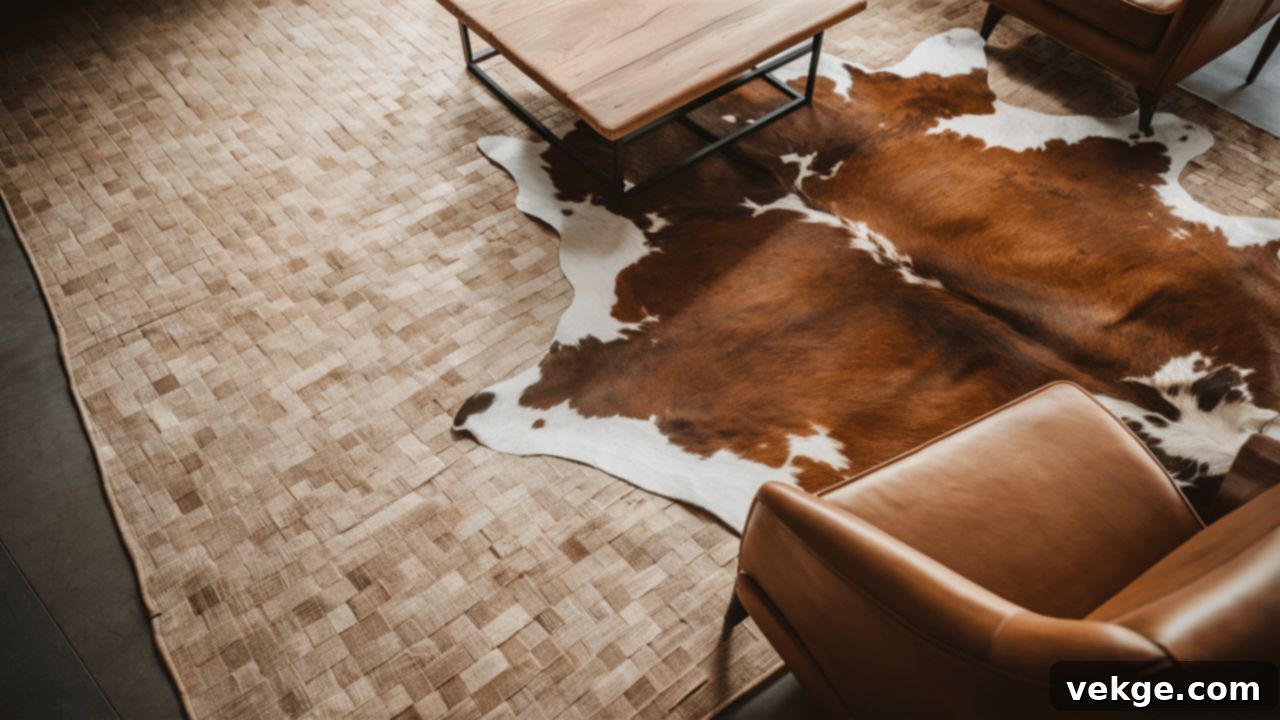
This combination introduces an organic, unexpected, and distinctly modern touch to a room, blending natural elements with a clean foundation.
- Why it works: The irregular, natural shape and unique texture of a cowhide rug beautifully soften the more structured lines and uniform appearance of a flatweave rug. This creates an intriguing interplay of forms and textures that adds significant depth and visual interest.
- Best for: This pairing is well-suited for contemporary living rooms, home offices, and rustic-chic spaces, offering a unique focal point.
- Tips: To enhance the effortless, artful layered look, consider placing the cowhide rug at a slight angle over the flatweave. If your base rug features a strong color, opt for neutral tones in the cowhide to maintain balance and prevent overwhelming the space.
6. Wool Rug + Smaller Accent Rug: Classic Comfort Meets Personal Flair

Utilizing a luxurious wool rug as the foundation provides unparalleled warmth and comfort, while a strategically placed smaller accent rug injects a dose of personal style and visual interest.
- Why it works: Wool rugs are celebrated for their natural thickness, exceptional coziness, and inherent durability, making them an ideal, soft foundation. The smaller top rug can then serve as a delightful pop of contrasting color, pattern, or texture without visually dominating the entire space.
- Best for: This classic combination excels in bedrooms, inviting living rooms, and cozy reading nooks where comfort and subtle elegance are prioritized.
- Tips: Choose a soft, high-quality wool rug as your base. Layer it with a woven kilim rug, a patterned cotton rug, or even a sheepskin for added textural contrast and a personalized touch.
How to Layer Rugs Effectively in Different Rooms of Your Home
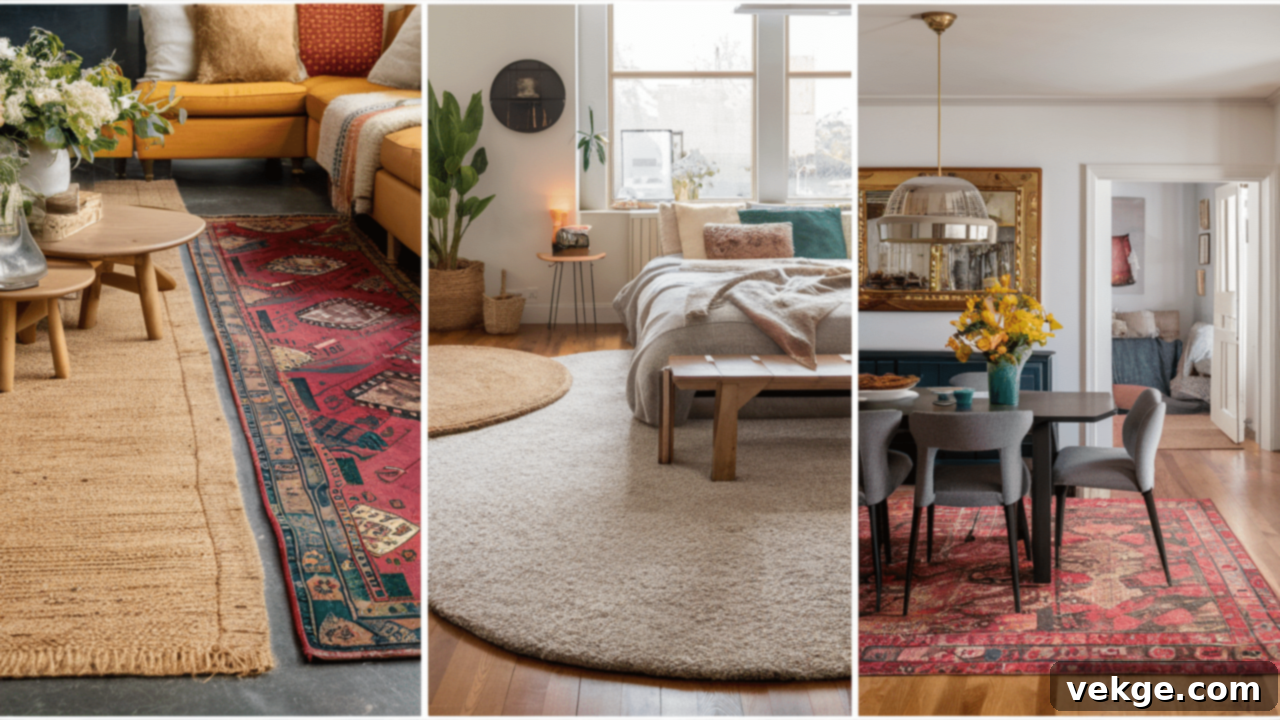
While the principles of layering rugs are universal, the specific application should always be tailored to the unique function, traffic patterns, and existing style of each individual room. Here’s how to adapt the art of rug layering for different areas of your home:
1. Layering Rugs in the Living Room: The Heart of Your Home
- How to do it: Begin with a generously sized base rug that extends well under your main furniture pieces, such as the sofa and armchairs, anchoring the entire seating area. Then, add a smaller, decorative top rug directly in front of the sofa or centrally within the seating arrangement, perhaps under a coffee table, to create a focal point.
- Best combinations: Jute + vintage rug for an eclectic, lived-in feel; flatweave + shag rug for ultimate comfort and a luxurious touch.
- Tips: Ensure that at least the front legs of all major furniture pieces rest comfortably on the base rug. This creates a cohesive and well-defined look, preventing the rugs from looking like they’re floating. If your sofa and chairs are neutral, this is your chance to go bold and expressive with a vibrant, patterned top rug.
2. Layering Rugs in the Bedroom: Your Personal Sanctuary
- How to do it: Place a large rug under the bed, allowing it to extend significantly on all sides to elegantly frame the sleeping area. Subsequently, introduce a smaller accent rug at the foot of the bed or on either side, perfect for adding an extra layer of warmth and plushness right where you step out of bed.
- Best combinations: A neutral wool rug + a patterned top rug for softness with visual interest; flatweave + shag rug for a cloud-like, supremely cozy atmosphere.
- Tips: Especially if you have hard flooring, a plush top rug will make those first morning steps wonderfully comfortable. Be mindful of overly thick layers around the bed, as they could potentially create tripping hazards or make furniture uneven.
3. Layering Rugs in the Dining Room: Functional Elegance
- How to do it: A single, large rug is typically paramount here, ensuring it’s big enough so that all chair legs remain on the rug even when pulled out. If you choose to layer, ensure the top rug is thin and flat, so it doesn’t obstruct chair movement or create an unstable surface.
- Best combinations: A durable low-pile wool rug + a thin kilim rug for a touch of pattern; jute rug + flatweave rug for natural texture and easy maintenance.
- Tips: In a dining room, it’s crucial to avoid high-pile rugs for both layers, as they can make chairs unsteady and difficult to move. Prioritize durable, stain-resistant, and easy-to-clean materials, as dining areas are prone to spills and heavy use.
4. Layering Rugs in the Entryway: Making a Grand First Impression
- How to do it: Start with a robust, large, and highly durable rug as your base to effectively protect the underlying floor from dirt and wear. On top, introduce a smaller, more decorative rug to welcome guests with style and warmth.
- Best combinations: Jute + a patterned runner or doormat; flatweave + a small cowhide rug for an unexpected, chic touch.
- Tips: Given that entryways are high-traffic zones, it is absolutely essential to use rug pads or non-slip backing for both rugs to prevent any shifting or slipping. Opt for materials that are exceptionally easy to clean and maintain, as this area will accumulate the most dirt.
How to Keep Layered Rugs Securely in Place: Practical Solutions
One common challenge with layered rugs, particularly on hard flooring surfaces, is their tendency to shift and slide, which can be both annoying and a tripping hazard. Fortunately, several effective strategies can help keep your beautifully layered rugs firmly in place:
- Utilize high-quality rug pads: Place a non-slip rug pad beneath your base rug. These pads not only prevent slipping but also add an extra layer of cushioning and protect your floors from abrasive rug backings.
- Employ double-sided rug tape: For added security, especially with the top rug, use double-sided rug tape to adhere it discreetly to the base rug. This creates a more unified surface and prevents the top layer from curling or moving independently.
- Strategic furniture placement: Position heavy furniture, such as sofas, beds, or credenzas, with their legs resting on the rugs. The weight of the furniture acts as a natural anchor, significantly reducing movement.
- Non-slip gripper mats: For smaller accent rugs, specialized non-slip gripper mats can be placed directly underneath to provide excellent traction and keep them firmly in position.
Common Rug Layering Mistakes to Avoid for a Polished Look
Even with the best intentions and the most beautiful rugs, layering can sometimes go awry. Being aware of common missteps can help you achieve a polished, professional look. Here are crucial mistakes to watch out for when styling your layered rugs:
- Using Rugs That Are Too Similar: The essence of effective layering is contrast. If both your rugs share nearly identical textures, colors, or patterns, they will blend into each other rather than creating a distinct, multi-dimensional effect. Always aim for differences in material, pile height, or design to achieve visual depth.
- Choosing the Wrong Sizes: A fundamental rule is that the base rug should be significantly larger, serving to anchor the entire space, while the top rug should be distinctly smaller to create a defined focal point. If the sizes are too close, the layering effect will be lost, and the arrangement might look awkward or unintentional.
- Not Securing Rugs Properly: Unsecured layered rugs are not just an aesthetic flaw; they are a safety hazard. Rugs that slide or bunch up can cause trips and falls. Always use high-quality rug pads underneath the base rug and consider double-sided rug tape to fix the top rug to the bottom. This is especially critical in high-traffic areas like entryways and living rooms.
- Adding Too Many Layers: While layering is about depth, there is a fine line between a stylish arrangement and a cluttered mess. Stick to two primary layers for a clean, sophisticated, and balanced look. More than two can often make a room feel heavy and overdone.
- Ignoring Room Size and Scale: The size of your rugs should always be proportional to the size of the room. Large, expansive rooms can gracefully accommodate sizable layered rugs without feeling overwhelmed. However, in smaller spaces, overly large or bulky layered rugs can make the room feel cramped and diminish its perceived size. Always scale your rug choices to fit the dimensions of your specific space.
Conclusion: Embrace the Art of Layering Rugs
Layering rugs has truly revolutionized the way I approach home styling, transforming ordinary spaces into extraordinary havens. It’s a remarkably effective and accessible method for adding warmth, intricate depth, and unmistakable personality to any room, all without the need for extensive renovations or a hefty budget. I particularly adore how the right combination of rugs can instantly evoke a sense of inviting coziness, modern sophistication, or playful charm.
The magic lies in the thoughtful interplay of elements: mixing patterns and textures to create captivating contrast, while carefully selecting colors to maintain a harmonious and balanced aesthetic. Through experimentation and a little practice, I’ve learned that precise pairing of rugs is the secret ingredient that makes all the difference in achieving a truly polished and inviting look.
I wholeheartedly encourage you to explore the creative potential of layering rugs in your own home. Begin by assessing the rugs you already own, then venture into experimenting with new textures and colors. Don’t be afraid to adjust and refine as you go. With a dash of creativity and a willingness to play, you can effortlessly craft a living space that feels both profoundly comfortable and impeccably stylish.
Frequently Asked Questions About Layering Rugs
How Do I Choose the Right Base Rug for Layering?
Select a large, neutral-colored rug with a low pile, such as jute, flatweave, or a durable wool. Ensure it’s big enough to anchor your furniture and the overall space, acting as a subtle foundation for your top rug.
Should the Top Rug Always Be Smaller than The Base Rug?
Yes, ideally. The top rug should typically be at least 12–24 inches smaller than the base rug on all sides. This creates a clear, intentional layered effect and prevents the top rug from appearing to simply cover, rather than complement, the base.
Can I Layer Two Patterned Rugs Together?
Absolutely, but with caution. To make this work, choose patterns that share complementary colors and, crucially, vary significantly in scale. For instance, a large-scale geometric pattern can pair beautifully with a smaller, more subtle floral or abstract print.
What Is the Best Way to Layer Rugs in a Small Room?
In a smaller room, opt for a light-colored base rug to visually expand the space. Keep the top rug relatively small to avoid overcrowding, and choose patterns that are simple or subtle to maintain a balanced and airy feel.
How Can I Layer Rugs to Define Spaces in An Open Floor Plan?
Start by placing a large, often neutral, base rug to clearly delineate the primary functional area, such as the living zone. Then, layer a smaller, accent rug strategically under a coffee table or within a specific seating arrangement to create a distinct focal point and further define a sub-zone.
